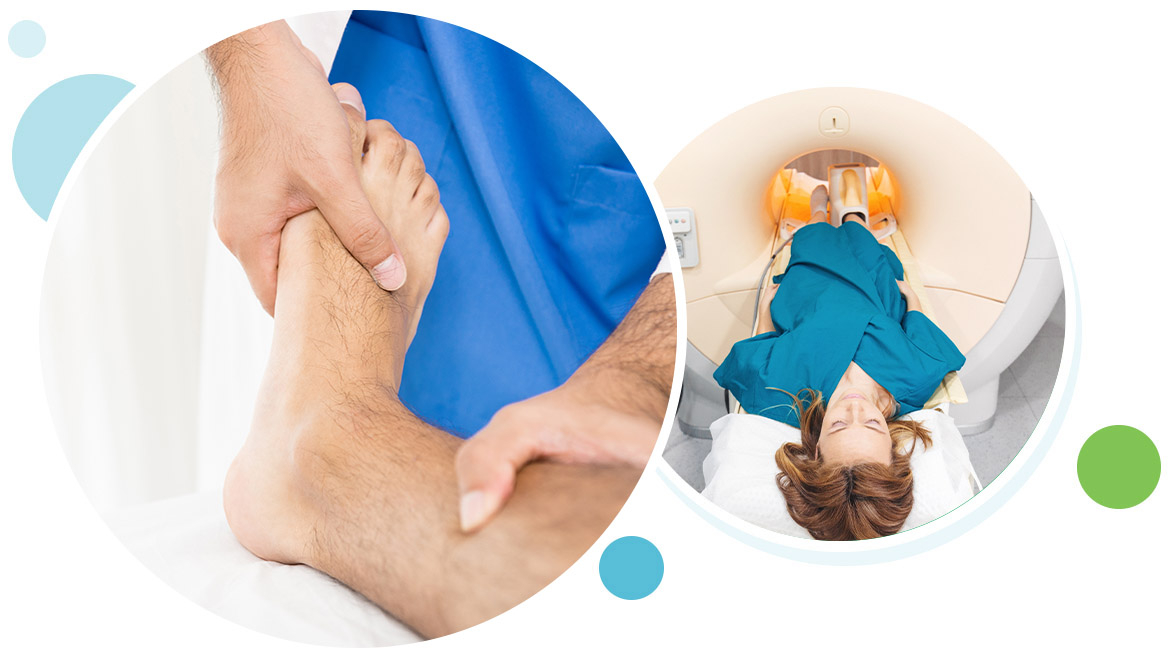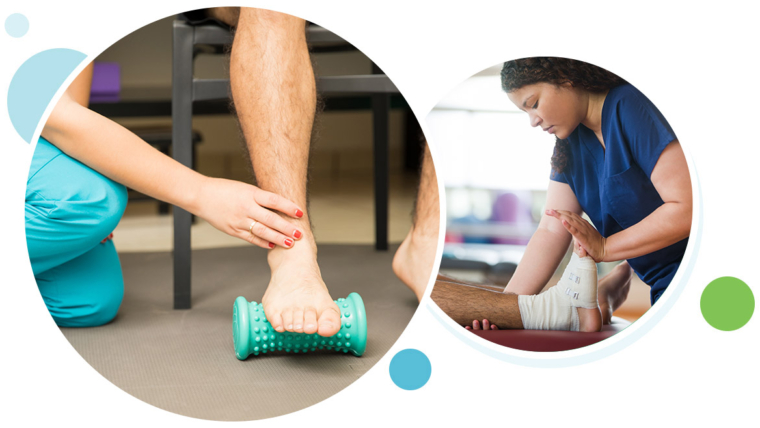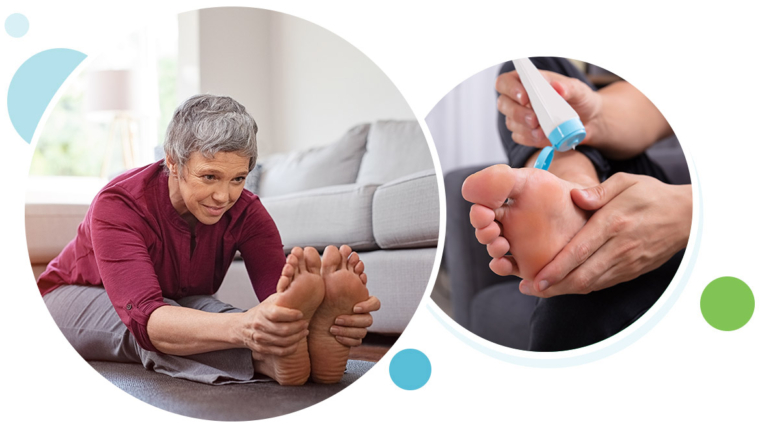When Should You See a Podiatrist?
At Northstate Foot and Ankle, we’re dedicated to providing total foot and ankle care, from your first check in, to any imaging needs, custom orthotic creation and all the way through your recovery process with physical therapy. We believe that we can provide the best treatment by offering complete podiatric services, all in house. Each step of our care is directly focused on what we do best – helping patients regain full foot and ankle health.
Many of our patients don’t necessarily understand the full range of benefits of seeing a podiatrist, and aren’t sure when they should make that choice. What are the reasons to choose a specialist over a walk-in clinic or general M.D.? What exactly does a podiatrist offer that a generalist might not? And what does that mean to my foot and ankle health? These are the questions we’re going to answer in this article.
What do Podiatrists Do?
Before we discuss why a person should see a podiatrist, let’s take a look at what podiatrists do. Podiatrists are medical professionals who specialize in treating conditions related to the foot, ankle and lower leg. You may also hear podiatrists referred to as Doctors of Podiatric Medicine (DPM), Podiatric Physicians or simply Foot Doctors. The last reference isn’t very accurate since the focus of their expertise covers much more than the foot. These specialized doctors help determine the best strategy for treating and recovering from all lower extremity medical conditions and injuries by conducting x-rays and lab tests, performing surgeries, prescribing medicines and orthotic devices, and much more.
Some of the medical conditions podiatrists treat include heel pain (plantar fasciitis), foot complications from diabetes, ankle and foot arthritis, nerve problems, tendonitis, hammertoes, flat feet, nail disorders, bunions, warts, fungus, fractures, and sprains. Given the amount of abuse our feet are subjected to in our daily lives, and considering that the human foot has 26 bones, 33 joints and more than 100 muscles that are used every single day, it’s not surprising that many people suffer from some form of foot and ankle pain during their lives. It is in everyone’s best interest to take proper care of their feet and ankles; podiatrists are trained to do exactly that.
Preventative Care is Worth Every Penny
As the old adage goes, “An ounce of prevention is worth a pound of cure.” Consulting with a podiatrist while your feet and ankles are still healthy is the best way to prevent paying a much greater price later on. A podiatrist can help you avoid developing foot, toe, nail and lower leg problems by reviewing your lifestyle, habits of physical activity and footwear, and then making recommendations that are custom tailored to your individual situation. Many people in pain would pay anything to make the discomfort go away, but most avoid taking the necessary steps to prevent the pain in the first place.
Are You Experiencing Persistent Foot or Ankle Pain?
Most simply stated, if you answered ‘yes’ to this question, then you should consider seeing a podiatrist. Many people incorrectly assume that sore feet and ankles are a normal and unavoidable side effect of daily life. This is not true and foot and ankle pain is your body’s signal to you that something is wrong, whether it be due to a hereditary medical condition, repetitive motions at work or during exercise, wearing improper footwear or resulting from an injury. Podiatrists can help you quickly identify the source of your pain and prescribe the appropriate treatment plan to put you on the fastest path to recovery.
Below are a few of the most common ailments that podiatrists treat.
Heel Pain
Heel pain is possibly the most common persistent foot ailment that DPM’s (including ours) treat and it is caused from a variety of conditions and injuries. One of the most prevalent conditions that leads to heel pain is Plantar Fasciitis, which is a chronic inflammation of the connective tissue that extends from the toes to the heel bone. Other causes of heel pain include stress fractures, inflammation of the Achilles tendon, arthritis, bursitis, tumors, heel spurs, or nerve irritation. Regardless of which problem is causing heel pain, the discomfort can be debilitating and requires a diagnosis of the underlying condition and treatment. Podiatrists are able to properly diagnose the cause of your heel pain and the plan they prescribe for treating this pain will depend on what is found in the diagnosis. Treatment options range from getting the right orthotics, proper shoes or adding in-shoe padding, to physical therapy, to regenerative medicine options like Shockwave Therapy, MLS Laser Therapy, PRP or amniotic injections, or administering anti-inflammatory medication and corticosteroid injections.
Because heel pain is one of the most common issues we treat and we know a lot of people don’t have time to or can’t get into see a doctor, don’t want to spend money on products that don’t work, or simply don’t know what to trust, try, buy or do, we developed the Foot Pain Kit. The Foot Pain Kit by Cure*ated powered by Northstate Foot and Ankle Specialists takes the guesswork out of foot pain treatment by providing the actual products and physical therapy exercises that we use with our patients and that we know work. The Kit’s products help control the biomechanics to relieve stress on the fascia or nerve, addressing the root cause while also reducing inflammation without the need for medication. The exercises included with the Kit get the nerve moving again and serve to strengthen and mobilize the supporting muscles and joints. To learn more visit www.cure-ated.com.
Sports Injuries
According to the Centers for Disease Control, 42% of athletic and recreational injuries affect the lower extremities (feet, ankles and lower legs). The most common diagnoses include sprains, strains and fractures. If you are active in sports, especially running, soccer, football or tennis the odds are that you may need to visit a podiatrist at some point. DPM’s often treat the following sports-related injuries:
Arthritis
Arthritis occurs when the inflammation of one or more joints causes the cartilage in those areas to become less pliable and to degenerate over time. This condition is common in the small joints of the ankle and foot, and arthritis can make it difficult to walk and participate in everyday activities. The deteriorated cartilage in the joints causes us to adjust our natural gait, leading to stiffness and pain in the knees, legs and hips. The three major kinds of arthritis that can affect the lower extremities include post-traumatic arthritis, rheumatoid arthritis (a disease affecting the joint cartilage) and osteoarthritis which is caused by a breakdown of a joint’s cartilage over time. While there is no cure for arthritis, there are multiple treatment options to help slow the progression and to help relieve its symptoms such as physical therapy, medications, lifestyle modification and assistive devices. Podiatrists are able to use a range of imaging tools such as MRI and perform in person tests to determine the stage of development and the best course of treatment.
Flat Feet & Hammertoes
Adult acquired flatfoot has many causes, including PTTD (posterior tibial tendon dysfunction), Charcot arthropathy, trauma, and congenital deformities. If left untreated the condition can result in pain and possibly degeneration of the midfoot/hindfoot joint complexes. Flat feet can lead to tenderness, pain and cramping in the knee, leg, and foot. In adulthood this may create mobility challenges and high levels of foot and ankle pain. While flat feet often appear in children, they may be asymptomatic and progressive, intensifying later in life and only then requiring the attention of a podiatrist. There are several ways of treating flat feet, often including physical therapy, shoe selection, orthotic devices, anti-inflammatory drugs and possibly surgical corrections.
Hammertoes are a bending deformity of one or both joints located in the second through fifth toes. While it can be present at birth, the condition usually develops because of poor-fitting shoes that are too tight or that have pointed heels. Usually starting as mild deformities and then worsening over time, if left untreated hammertoes can become much more rigid and non-responsive to treatment. Since it is a progressive condition, it needs immediate attention and will not improve without medical care. However, it is usually very treatable. The treatment your podiatrist recommends is dependent on your condition’s severity and several other factors.
Neuromas & Metatarsalgia
Neuromas result in an intense burning, tingling pain in the feet that is a symptom of swelling and thickening of the nerve that leads to the toes, which is caused by compression and irritation of the foot. It can be a very painful condition, with symptoms worsening as the nerve enlarges. Women that wear narrow, high-heeled shoes are much more likely to suffer from the nerve condition. A podiatrist will come up with a treatment plan based on how far the neuroma has progressed and offer guidance for how to avoid this condition from developing again.
If you experience chronic pain in the ball of your foot, you may have metatarsalgia. Metatarsalgia is caused when the ball of your foot becomes painfully inflamed and often results from participation in sports or exercises that involve running or jumping and sometimes from wearing tight-fitting shoes or other foot deformities.
Trauma and Crush Injuries
Trauma and crush injuries can result from accidents playing sports, dancing, running, vehicular accidents, and so forth. These are serious foot injuries can involve broken or crushed bones and damage to tendons, ligaments, muscles and the vascular system. Trauma and crush injuries can cause severe pain in the short term and lead to complications in the long term. Your physician will conduct a physical examination and will likely use imaging (such as x-ray, MRI or CT scan) to determine the severity of the injury and come up with an effective treatment plan. This plan may include surgery, medication and physical therapy.
Bunions
Bunions are bumps on the joint at the base of the big toe. They force the toe to bend towards the others, often creating a painful lump of bone on the foot. Since the foot carries a great deal of the body’s weight when walking, bunions can result in severe pain if left untreated. An untreated bunion can make wearing shoes difficult, if not impossible and could lead to foot deformities such as hammertoe, corns, calluses, and ingrown toenails. Podiatrists may recommend orthotics to relieve pain, the removal of corns and calluses, padding and taping, physical therapy, and medication. If early treatment fails, podiatrists can surgically remove bunions.
Ingrown Toenails
An ingrown toenail occurs when the edges of a nail grow into the skin of the toe. When the nail breaks through the skin, it creates inflammation. Initially, an ingrown toenail may only cause minor discomfort. However, it could progress to severe inflammation and infection. Sometimes ingrown toenails are a hereditary condition, but other medical conditions may also contribute to the development of ingrown toenails and athletes are particularly prone to developing them. Catching and treating an ingrown toenail early will significantly lessen the chance of a treatment like surgery. There are a wide range of treatment options available and a podiatrist will help to determine the best solution depending on how far the issue has progressed, and any related problems that may occur.
Warts
Warts are small growths that develop after a virus infects the skin. While warts can form anywhere on the foot, most appear on the bottom, which is called the plantar side of the foot. Children, the elderly, and adolescents are much more likely to have foot warts. While warts might clear up on their own, patients usually want to resolve their plantar wart issue quickly with wart removal. With the goal of completely removing the wart, the doctor will come up with a treatment plan. Topical ointments, acid treatments, cryotherapy or oral treatments might be ordered. Sometimes the wart might have to be surgically removed. If the wart doesn’t respond to treatment, a biopsy might be ordered to determine whether they may be another cause of the growth.
Fungus
Toenail fungus is a common issue that can affect all ages. It usually begins as a skin infection and is similar to athlete’s foot, but specifically affects the nails. Generally the fungus starts underneath the fold at the end of the nail, and as time passes, it continues to grow under the nail and causes the nail’s appearance to change. This discoloration commonly leaves the nail looking brown or yellow and also may cause the toenail to thicken or look deformed. Toenail fungus can often be treated with antifungal medications although in extreme cases the toenail may need to be removed completely.
Finding The Best Footwear For Your Health & Happiness
Every foot is different and most shoes do not properly support all of the unique ways each of us use our feet. That is why podiatrists perform biomechanical analysis to determine the best types of shoes for your feet and ankles. Biomechanical analysis allows podiatrists to understand the alignment of your feet with the rest of your lower extremities including your knees and hips, which when understood, enables DPM’s to prescribe the correct footwear, supportive inserts or custom orthotics where needed to target your specific condition. Proper footwear and the fitting of custom orthotics is an important part of preventing issues, minimizing or resolving conditions with non-surgical treatments, as well as ensuring proper healing and quick recovery after foot or ankle surgery.
Final Thoughts
If you are experiencing chronic foot, ankle or lower leg pain, you should schedule an appointment with a podiatrist as soon as possible. Podiatrists are highly trained specialists who use a range of testing methods to diagnose your pain and recommend treatments to get you started on your path to a healthy body and a more enjoyable life as quickly as possible. Keep in mind that you don’t have to wait until your feet and ankles are in pain to visit your local foot and ankle specialist! Podiatrists can help you maintain healthy feet and ankles, which will hopefully allow you to avoid potential problems and discomfort down the road.
Contact our office today at 530-891-3338 (FEET) for an appointment!



